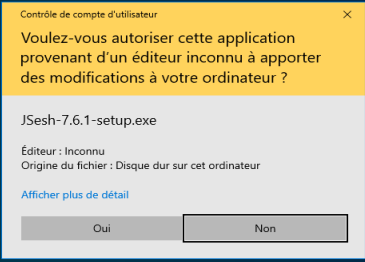On “recent” windows computers (well, after Windows 7 if I remember well, which means recent means something like less than ten years old), the user is protected against installing unsigned softwares.
To make a long story short, this is a trend which began on smartphones, with the creation of application stores (although there is also a possibility in Unix to sign softwares). It's a system which has got its uses. Mostly, the user can be sure to install exactly the software the author has written, and not a modified version.
The downside is that developpers must register with Microsoft (or Apple for the Mac), and pay just to be able to sign their softwares.
I consider this as a rip off, especially for free software developpers as yours truly.
Hence I don't, and I won't, register. The result is that, when installing JSesh, you will get some alarming messages from Windows. I'm going to guide you through them.
First and foremost: to be sure to install a legitimate version of JSesh, the best way is to get it from this site. Just check that the URL of the site is https://jsesh.qenherkhopeshef.org, and that you have the “lock” symbol on your browser: 🔒, next to the name of the site.
Also note that my Window version is in French, so the English messages might be a little bit different from those I wrote.
Get the Windows version of JSesh (through the link Download Windows Version). The JSesh for all computers version can also be used on Windows, but will be less easy to use.
You will get an installer software. When you run it, you will see a message like this :
 .
.
You should click on the “more information” text link below the message (not on the button). In my case, on a French version of Windows, it says « informations complémentaires. »
The warning window will change a little bit, and you will see the following:
 .
.
You can click on the left button, “execute anyway”. You will get this window if you have admin rights, with the message Do you want to allow this app from an unknown publisher to make changes to your device:
 .
.
Click yes and proceed to JSesh installation.
Once more, be sure to install a JSesh version from this site (or https://github.com/rosmord/jsesh, as it's the place where I actually store the files).